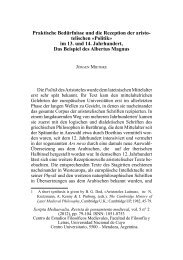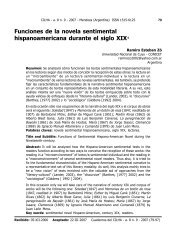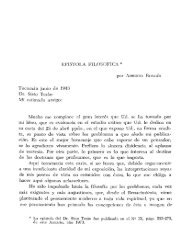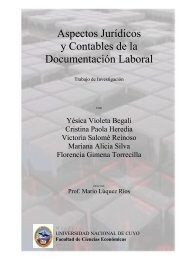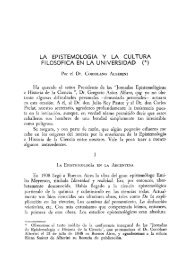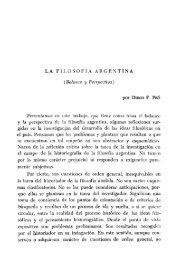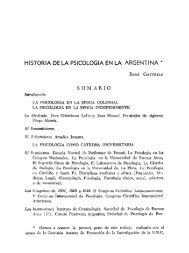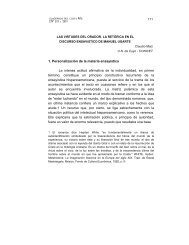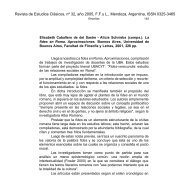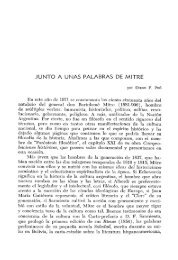Cambio Climático del Ecosistema Semiárido Transicional en Chile ...
Cambio Climático del Ecosistema Semiárido Transicional en Chile ...
Cambio Climático del Ecosistema Semiárido Transicional en Chile ...
You also want an ePaper? Increase the reach of your titles
YUMPU automatically turns print PDFs into web optimized ePapers that Google loves.
3.7. IV Región de Coquimbo<br />
El sistema regional está repres<strong>en</strong>tado por la totalidad de las estaciones de aforo exist<strong>en</strong>tes y<br />
validadas metodológicam<strong>en</strong>te. En la cu<strong>en</strong>ca <strong>del</strong> río Elqui se <strong>en</strong>cu<strong>en</strong>tra repres<strong>en</strong>tado por Río Elqui<br />
<strong>en</strong> Alm<strong>en</strong>dral (1), Río Elqui <strong>en</strong> Algarrobal (2), Río Claro <strong>en</strong> Rivadavia (3), Río Turbio <strong>en</strong> Varillar (4)<br />
y Río La Laguna <strong>en</strong> salida Embalse La Laguna (5). La cu<strong>en</strong>ca <strong>del</strong> río Limarí por Río Limarí <strong>en</strong><br />
Panamericana (6), Río Hurtado <strong>en</strong> <strong>en</strong>trada Embalse Recoleta (7), Río Hurtado <strong>en</strong> Angostura de<br />
Pangue (8), Río Hurtado <strong>en</strong> San Agustín (9), Río Grande <strong>en</strong> Puntilla San Juan (10), Río Rapel <strong>en</strong><br />
Junta (11), Río Los Molles <strong>en</strong> Ojos de Agua (12), Río Mostazal <strong>en</strong> Cuestecita (13), Río Grande <strong>en</strong><br />
Cuyano (14), Río Tascadero <strong>en</strong> Desembocadura (15), Río Grande <strong>en</strong> Las Ramadas (16), Río<br />
Guatulame <strong>en</strong> El Tome (17), Río Cogotí <strong>en</strong> <strong>en</strong>trada Embalse Cogotí (18), Río Cogotí <strong>en</strong> Cogotí 18<br />
(19), Río Pama <strong>en</strong> <strong>en</strong>trada Embalse Cogotí (20) y, Río Punitaqui <strong>en</strong> Chalinga (21). El Choapa por<br />
las estaciones Río Choapa aguas arriba Estero La Canela (22), Río Illapel <strong>en</strong> Huintil (23), Río<br />
Illapel <strong>en</strong> Las Burras (24), Río Choapa <strong>en</strong> Pu<strong>en</strong>te Negro (25), Estero Camisas <strong>en</strong> Desembocadura<br />
(26), Río Choapa <strong>en</strong> Salamanca (27), Río Cuncumén antes de Bocatoma de Canales (28) y, Río<br />
Choapa <strong>en</strong> Cuncumén (29).<br />
1 2 3 4 5 6 7 8 9 10 11 12 13 14 15 16 17 18 19 20 21 22 23 24 25 26 27 28 29<br />
Año + + + + + + + + + + + + + + + + + + + + + + - = + + + + +<br />
Ene + + + + + + + + + + + + + + + + + + + + - + - + + + + - +<br />
Feb + + + + + + + + + + + + + + + + + + + + + + - - + - + - +<br />
Mar + + + + + + + + + + + + + + + + + + + + + + - - + - + - +<br />
Abr + + + + + + + + + + + + + + + + + + + + + + - - + - + - +<br />
May + + + + + + + + + + + + + + + + - - - - - + - - + - + - +<br />
Jun + + + + + - + + + + + + + + + + - - - - - - - - - - - - -<br />
Jul + + + + + + + + + + + + + + + + + + + + + + - - + + + + +<br />
Ago + + + + + + + + + + = + + + + + + + + + + + + - + + + + +<br />
Sep + + + + + + + + + + + + + + + + + + + + + + + - + - + - +<br />
Oct + + + + + + + + + + + + + + + + + + + + - + + + + + + + +<br />
Nov + + + + + + + + + + + + + + + + + + + + - + + + + + + + +<br />
Dic + + + + + + + + + + + + + + + + + + + + - + + + + + + + +<br />
Tabla 38. T<strong>en</strong>d<strong>en</strong>cia de Caudales Medios Regionales<br />
(Donde (+) t<strong>en</strong>d<strong>en</strong>cia positiva, (=) t<strong>en</strong>d<strong>en</strong>cia estable, (-) t<strong>en</strong>d<strong>en</strong>cia negativa)<br />
El comportami<strong>en</strong>to g<strong>en</strong>eral de las cu<strong>en</strong>cas y subcu<strong>en</strong>cas regionales <strong>del</strong> ecosistema semiárido<br />
transicional de <strong>Chile</strong>, muestra una clara t<strong>en</strong>d<strong>en</strong>cia al increm<strong>en</strong>to de los caudales naturales<br />
(Figura 2). Esta t<strong>en</strong>d<strong>en</strong>cia positiva se refleja <strong>en</strong> forma determinante para los meses de agosto<br />
(Figura 10), octubre (Figura 12), noviembre (Figura 13) y diciembre (Figura 14). Seguidos<br />
con dos meses <strong>en</strong> decrecimi<strong>en</strong>to por el mes de julio (Figura 9). Con tres meses <strong>en</strong> decrecimi<strong>en</strong>to<br />
para <strong>en</strong>ero (Figura 3) y septiembre (Figura 11). Con cuatro meses decreci<strong>en</strong>tes <strong>en</strong> febrero<br />
(Figura 4), marzo (Figura 5) y abril (Figura 6). Los meses que pres<strong>en</strong>tan un mayor<br />
decrecimi<strong>en</strong>to de caudales correspond<strong>en</strong> a junio (Figura 8) y mayo (Figura 7), lo que involucra a<br />
un total de 14 y 9 subcu<strong>en</strong>cas respectivam<strong>en</strong>te.<br />
En la distribución regional de las t<strong>en</strong>d<strong>en</strong>cias de caudales naturales, destaca el que las dinámicas<br />
de decrecimi<strong>en</strong>to se conc<strong>en</strong>tr<strong>en</strong> hacia el extremo sur de la región (extremo sur de la cu<strong>en</strong>ca <strong>del</strong><br />
Limarí y cu<strong>en</strong>ca <strong>del</strong> Choapa), con énfasis <strong>en</strong> los meses de mayo y junio (otoño-invierno).<br />
57



